Home > Auctions > 3 - 11 June 2025
Ancient Art, Antiquities, Books, Natural History & Coins
From the collection of a gentleman, acquired on the London art market in the 1990s.
This lot is accompanied by an illustrated lot declaration signed by the Head of the Antiquities Department, Dr Raffaele D'Amato.
Cf. A. De Caluwe, A., Un "Livre des Morts" sur bandelette de momie, Brussels, 1991, for a discussion of the longest known mummy bandage.
From the fifth century B.C., mummy wrappings often feature hieratic script—a cursive form of Egyptian hieroglyphs used for daily and religious texts. These include excerpts from funerary works like the Book of the Dead, alongside prayers meant to protect the deceased in the afterlife. Often with vignettes, these texts were inscribed directly on linen strips during the mummification. Some bandages were notably long; one from Brussels, 6.2 cm wide, measures an incredible 26 metres.
Ex Prof. Dr Emil Vogt (1906-1974), The Former Director of the Swiss National Museum, Zürich, in his collection before 1970.
with Galerie Rhéa, Zurich, Switzerland.
This lot is accompanied by an illustrated lot declaration signed by the Head of the Antiquities Department, Dr Raffaele D'Amato.
Cf. Petrie, W.M.F., Amulets. Illustrated by the Egyptian Collection in University College, London, 1914, pl. XXVIII, 158n, for a similar Osiris-Canopus amulet in bronze; Petrie, W.M.F., Amulets. Illustrated by the Egyptian Collection in University College, London, 1914, pl. XXVId and XXVIe, for similar Isis lactans amulets; Daressy, G., Catalogue général des antiquités égyptiennes du Musée du Caire N° 38001-39384 Statues de divinités, Cairo, 1906, pl. VIII, no. 38.229, for a Shu of similar form.
Acquired in the mid 1980s-1990s.
Private collection, Switzerland, thence by descent.
Private collection, since the late 1990s.
This lot is accompanied by an illustrated lot declaration signed by the Head of the Antiquities Department, Dr Raffaele D'Amato.
Cf. Ben-Tor, D., The Scarab: A Reflection of Ancient Egypt, Tel Aviv, 1993, p. 77, nos. 13-15, for comparable diorite scarabs.
The scarab amulet was arguably the most ubiquitous symbol in ancient Egypt, representing rebirth, transformation, and protection. Modelled after the scarab beetle, which was associated with the sun god Khepri, believed to roll the sun across the sky, the amulet illustrated the cycle of life and regeneration. Scarabs were commonly placed with the deceased as funerary amulets to ensure safe passage into the afterlife. They also served as seals and personal charms, often inscribed with prayers, names, or protective formulas. Widely used from the early Middle Kingdom (c. 2050 BCE) onwards, scarab amulets reflect spiritual beliefs and everyday practices in ancient Egyptian life.
From an early 20th century collection.
This lot is accompanied by an illustrated lot declaration signed by the Head of the Antiquities Department, Dr Raffaele D'Amato.
Cf. Andrews, C., Amulets of Ancient Egypt, London, 1994, item 29(c).
The cat was sacred to Bastet, a protective mother goddess and the daughter of the sun god Re. Amulets offered the wearer the goddess's protection. Her name means ‘she of the bast [ointment jar],’ which may have contained a substance favoured by or exclusive to royalty. Originally, Bastet was depicted as a woman with the head of a lioness, but by the late New Kingdom, she was usually shown with a cat's head. She is sometimes portrayed with kittens, emphasising her maternal role as a fierce protector of offspring.
From the collection of a gentleman, acquired on the London art market in the 1990s.
This lot is accompanied by an illustrated lot declaration signed by the Head of the Antiquities Department, Dr Raffaele D'Amato.
Cf. Matouk, F.S., Corpus du scarabée égyptien. Vol. 2: Analyse thématique, Beirut, 1976, 355, no. 1532, for a similar thematic scarab design.
Ex H. Norry collection, Milton Keynes, UK, 1980s-1990s.
This lot is accompanied by an illustrated lot declaration signed by the Head of the Antiquities Department, Dr Raffaele D'Amato.
Cf. Berlev, O. and Hodjash, S., Catalogue of Monuments of Ancient Egypt: From the Museums of the Russian Federation, Ukraine, Bielorussia, Caucasus, Middle Asia and the Baltic States, Orbis Biblicus et Orientalis 17, Fribourg/Göttingen, 1998, pl. 196, XVII. 265-361, for comparable examples.
with Bonhams, London, 27 April 2006.
with Galerie Rhéa, Zurich, Switzerland.
This lot is accompanied by an illustrated lot declaration signed by the Head of the Antiquities Department, Dr Raffaele D'Amato.
The ‘Treasurer of the god’ is a long-attested title known since the Old Kingdom (Jones, D., An Index of Ancient Egyptian Titles, Epithets and Phrases of the Old Kingdom, vol. II, Oxford, 2000, p. 767, no. 2791). The ‘Chief keeper’ title is known from the New Kingdom (for a similar writing of the title, see Al-Ayedi, A.R., Index of Egyptian Administrative, Religious and Military Titles of the New Kingdom, Ismailia, 2006, p. 395, no. 1236). The last part of the title is somewhat curious; the determinative at the end, previously interpreted as ‘Ra’, does not match the determinative for this god in the second line. An alternative tentative interpretation could be ‘Chief keeper, of the gold of the Pharaoh’, treating the pr and ꜤꜢ signs, which are shown side-by-side, as writing ‘Pharaoh’, with the seated figure wearing the Dual Crown symbolising the ruler.
From the property of a lady since the early to mid 20th century.
From the private collection of Mr M.L. since circa 2005.
This lot is accompanied by an illustrated lot declaration signed by the Head of the Antiquities Department, Dr Raffaele D'Amato.
Cf. Tinius, I., Altägypten in Braunschweig. Die Sammlungen des Herzog Anton Ulrich-Museums und des Städtischen Museums, Wiesbaden, 2011, p. 115, no. 182, for a similar Isis figurine from Aswan, also with a notably long-horned headdress.
In ancient Egyptian mythology, Isis was the sister-wife of Osiris and the mother of the sky god Horus. She is associated with aspects of fertility and motherhood and is often depicted in various artworks seated in a nursing pose with her son Horus on her lap, as here.
Private collection, 1970s.
Private collection, 2017.
This lot is accompanied by an illustrated lot declaration signed by the Head of the Antiquities Department, Dr Raffaele D'Amato.
Cf. Tinius, I., Altägypten in Braunschweig. Die Sammlungen des Herzog Anton Ulrich-Museums und des Städtischen Museums, Wiesbaden, 2011, p. 152, no. 281, for a similar example.
In ancient times, the cat was revered as the sacred animal of the goddess Bastet, who was worshipped in Bubastis, located in the Nile Delta. She was a protective mother goddess and the daughter of the sun god Re. Amulets provided the wearer with the goddess's protection.
with Artemis Gallery, Munich, Germany, 1998.
Private collection, Europe.
This lot is accompanied by an illustrated lot declaration signed by the Head of the Antiquities Department, Dr Raffaele D'Amato.
Acquired in the mid 1980s-1990s.
Private collection, Switzerland, thence by descent.
Private collection, since the late 1990s.
This lot is accompanied by an illustrated lot declaration signed by the Head of the Antiquities Department, Dr Raffaele D'Amato.
Cf. El-Khouli, A., Egyptian Stone Vessels: Predynastic Period to Dynasty III, vol.3, London, 1974, pl. 81, no. 2181, for a vessel of similar form.
One of the most prestigious materials the Egyptians extracted was alabaster, more correctly referred to as travertine or calcite-alabaster. From the 1st through 3rd Dynasties, stone vessels were very popular items to include in the burials of pharaohs and nobles. No fewer than 30,000 stone vessels were found in the labyrinthine galleries below Djoser’s Step Pyramid at Saqqara, and Egyptian alabaster was used to make hundreds of those vessels.
Ex R. Liechti (1934-2010) Geneva, Switzerland, formed between 1950-1990s.
This lot is accompanied by an illustrated lot declaration signed by the Head of the Antiquities Department, Dr Raffaele D'Amato.
Cf. Matouk, F.S., Corpus du scarabée égyptien. Vol. 2: Analyse thématique, Beirut, 1976, pp. 384-385, for examples of scarab bases decorated with royal sphinxes accompanied by various symbols.
265 - 276 of 3130 LOTS

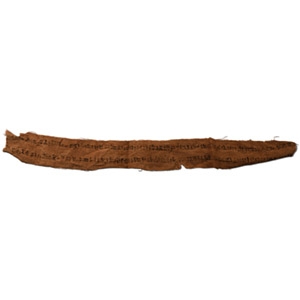


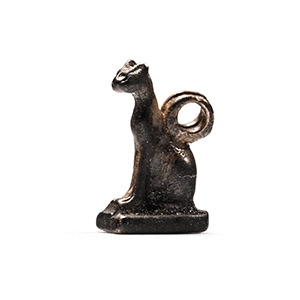
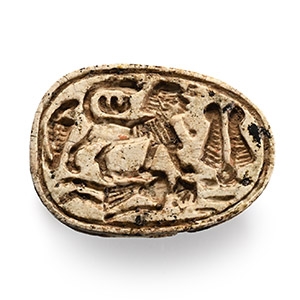
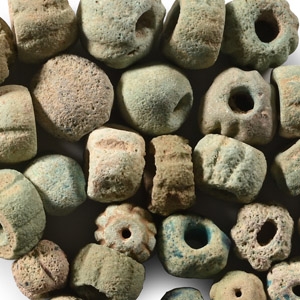
.jpg)
.jpg)
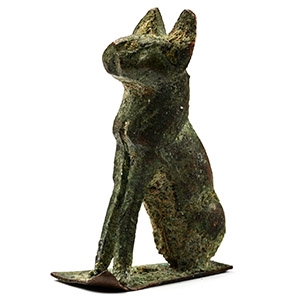
.jpg)
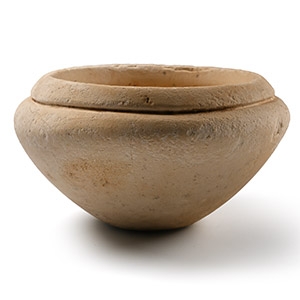
.jpg)



